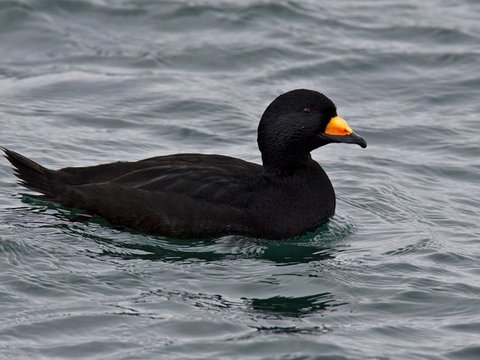If you were out at the lake this week, you may have spotted a large group of black birds swimming in circles together in the middle of the lake. These are Black Scoters. They often appear on Lake Iroquois in late October as they migrate south and east to the Atlantic coast. Nicknamed “Halloween birds” by Chip Wright due to the male colors- black body with orange beak - and their appearance here right around the end of October. Black Scoters are sea ducks, spending their summers in Arctic regions and migrating south to winter along the mid-Atlantic coast. They will briefly stop off to rest on inland freshwater lakes and ponds during migration. They feed on insects and small mollusks and crustaceans. Because Black Scoters nest in the very far north, it is difficult to estimate their population, but according to the Cornell University Ornithology Lab, it is believed that their numbers are declining, and they are considered “near endangered”. While they usually spend only a day or two on our lake each fall, they are always interesting and fun to see.
Milfoil Control Efforts
Eurasian Watermilfoil (EWM) was first identified near the public fishing access in Lake Iroquois around 1990. Various efforts were made to control the infestation including hand pulling, use of weevils, and establishment of the LIA Greeter Program. However, by 2014, it was clear that the EWM infestation was spreading out of control, seriously impeding boating, swimming, fishing, and causing an alarming decline in native aquatic species. In order to understand what was happening and what our options were, the LIA Board began to study and research options for reducing and controlling EWM, including conducting regular plant surveys.
The result of this work has been the development of an EWM Long-Range Management Plan that involves a multi-faceted approach. The plan includes a careful and judicious use of the herbicide, ProcellaCOR. This approach is balanced by historic and continued use of other methods such as diver-assisted suction harvesting (DASH), use of benthic (bottom) barriers in certain limited areas, hand pulling, and ongoing work to continue to reduce nutrient levels in the lake. These efforts serve as an integrated approach that when combined with LIA’s Greeter and Boat Wash Program, aim to prevent further introduction of invasives into the lake, to control and reduce the EWM invasive that is already there, and to prevent boats leaving Lake Iroquois from carrying EWM to other waterbodies.
ProcellaCOR was granted Reduced Risk Status by the US EPA in early 2016 because of its promising environmental and toxicological profiles. This product has been widely analyzed by universities, federal and state governments, and health departments. Findings show that professional application of ProcellaCOR in accordance with the label will not cause adverse effects on human health or the environment. Studies also indicate that chronic exposure did not result in carcinogenicity, mutagenicity, nor genotoxicity effects. In addition, ProcellaCOR breaks down quickly in the environment (hours to days).
In 2021 the Lake Iroquois Association was granted a permit to use ProcellaCOR to control the EWM infestation. The permit application, supporting documentation, the permit, permit application, and treatment plans can all be found below.
In June of 2021 approximately 37% of the littoral zone (near shore’ areas where these aquatic plants grow) was treated with ProcellaCOR. This is slightly less than 15% of the entire lake. The concentration rate used was 3 PDUs (Prescription Dose Units) which is equal to a rate of 1.93 ppb (parts per billion). At this rate on this proportion of the lake it is expected that the concentration level in the entire lake would be no more than 0.47 ppb on the day of application. For reference, imagine 1-2 drops in an Olympic-sized swimming pool. The results of the treatment showed nearly complete eradication of EWM, a light effect on some of the water lily leaves (slight browning), and by the end of summer, native aquatic plants had revegetated the area that had been nearly a monoculture of EWM.
The second treatment was carried out in July of 2024. Slightly more than 31% of the littoral zone was treated (about 12% of the total lake area) at the same dosage level previously used (3 PDU). Once again, the results were excellent with no milfoil detected in the treatment areas. The 2024 plant survey showing detailed results can be found here.
The EWM control work at Lake Iroquois has been primarily funded by the generosity of Lake Iroquois Association members and supporters. Additional funding supporting the greeter program, plant surveys, and milfoil control came from the towns of Williston, Hinesburg, and Richmond and from the Vermont Department of Environmental Conservation Grant-in-Aid Program.
Documents

Aquatic Nuisance Control Permit Renewal Application - November 2025
File size: 12 MB
File Extension: .pdf



Aquatic Nuisance Control Permit Issued February 8, 2021
File size: 428 KB
File Extension: .pdf
Permit for the use of the herbicide ProcellaCOR
Aquatic nuisance control permit application - herbicide
File size: 9 MB
File Extension: .pdf
Lake Iroquois




